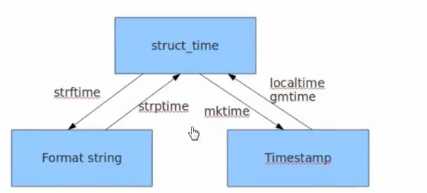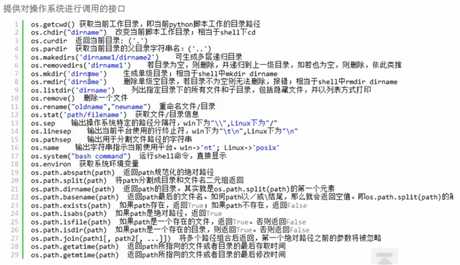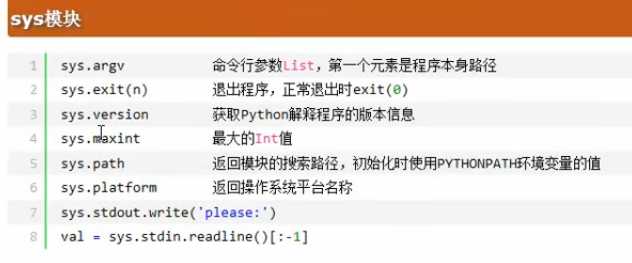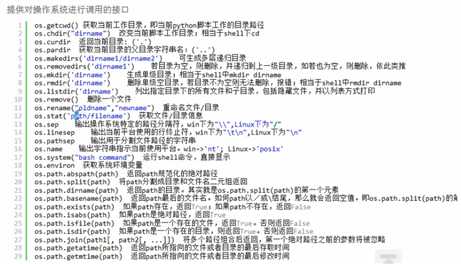标签:地址 浮点数 hive 类型 系统环境 dom bitbucket .config lag
1、import讲解
#本质就是.py 文件,用来从逻辑上组织pyhton代码(变量、函数、类、逻辑,实现一个功能)
1.1、导入方法
导入多个模块,以逗号隔开
例如 module模块: name = "kangkang" def fun(num): print("num",num) 1) import module print(module.name) #调用模块下的参数 module.fun(23) #调用模块下的方法 结果为: kangkang num 23 2)#是将module下的方法导入,若有相同的变量名、方法 会被覆盖 from module import * print(name) fun(23) 结果为: kangkang num 23 3)#as关键字,将导入的模块底下的方法取个别名 from module import fun as fun_mod fun_mod(23) 结果为: num 23
1.2、import 本质
import module 这种方式是将导入的模块先解释一遍,统一赋值给模块名,调用时用模块名.变量名(方法名)
from module import fun 这种方式是将对应的变量放到当前位置执行一遍
1.3导入包
导入包实际就是在跑 __init__.py 文件
#导入包的下的模块 1、在__init__.py文件下导入包 包(package) 包下的文件: name = "lily" print(name) 在包下的__init__.py文件导入模块 print("包下的__init__文件") #import test from .import test 2、在模块下导入包下对应的模块名 import package print(package.test.name) 结果为: 包下的__init__文件 lily lily
1.4导入优化
在当前函数多次调用了模块,直接用from导入运行一次模块

常用模块分三大块:1、标准库(Python解释器自带的) 2、第三方模块 3、自定义模块
1、time()模块
#time 模块,表示方式有 1)时间戳 2)元组(struct_time) 3)格式化字符串 import time print(time.time())#返回时间戳 秒为单位 #结果:1496244459.139784 print(time.localtime())#struct_time ,可传入值 #结果:time.struct_time(tm_year=2017, tm_mon=5, tm_mday=31, tm_hour=23, tm_min=27, tm_sec=39, tm_wday=2, tm_yday=151, tm_isdst=0)时区 夏令时 print(time.gmtime())#返回的是UTC时区的时间,是struct_time(tuple)格式 ,可传入值 #结果:time.struct_time(tm_year=2017, tm_mon=5, tm_mday=31, tm_hour=16, tm_min=2, tm_sec=10, tm_wday=2, tm_yday=151, tm_isdst=0) print(time.timezone) #-28800 ,-28800/3600=8,当前时间和UTC时间的差值 print(time.altzone) #-32400 当前时间和DST时间的差值 print(time.daylight) # 是否使用了夏令时 print(time.time()) print(time.sleep(3)) x = time.localtime()#获取该时间的年、月、日等 print(x) #结果:time.struct_time(tm_year=2017, tm_mon=5, tm_mday=31, tm_hour=23, tm_min=27, tm_sec=39, tm_wday=2, tm_yday=151, tm_isdst=0)时区 夏令时 print(x.tm_year) #结果:2017 其他的获取以此类推 #将struct_time 转化成时间戳 用mktime(元组) print(time.mktime(x)) #1496247520.0 #将struct_time转格式化字符串,用strftime("格式",元组) print(time.strftime("%Y-%m-%d %H:%M:%S",x)) #2017-06-01 00:23:00 #将字符串格式转换truct_time,用striptime("字符串","格式") print(time.strptime("2017-06-01 00:23:00","%Y-%m-%d %H:%M:%S")) #结果为:time.struct_time(tm_year=2017, tm_mon=6, tm_mday=1, tm_hour=0, tm_min=23, tm_sec=0, tm_wday=3, tm_yday=152, tm_isdst=-1) print(time.asctime()) # 传入的是元组 Thu Jun 1 00:41:16 2017 print(time.ctime()) #传入的是秒 Thu Jun 1 00:42:46 2017


2、datetime()
import datetime #获取当前时 print(datetime.datetime.now()) #2017-06-01 00:48:45.418119 print(datetime.datetime.now()+datetime.timedelta(3)) #往后推3天2017-06-04 00:48:45.418119 print(datetime.datetime.now()+datetime.timedelta(hours=3)) #往后推3个小时 2017-06-01 03:50:02.344519
3、random模块
import random print(random.random()) #获取随机数 随机一个0~1的浮点数 0.2989567744701819 print(random.uniform(1,6))#获取随机数,也是获得一个随机的浮点数 但可以指定范围 print(random.randint(1,6)) #随机获取1~6的值 2 print(random.randrange(1,3)) #随机获取1~2的值 顾头不顾尾 1 #help(random.randrange) print(random.choice("Dhjceret6768skd"))# 从序列中随机取一个 k print(random.sample("dujfdk",2)) #从序列中随机取2个数 [‘f‘, ‘d‘] #打乱顺序 I = [123,3,3,5,6,2,66] random.shuffle(I) print(I) #[5, 123, 3, 6, 3, 2, 66]
random应用实例
import random random_num = "" for i in range(7): num = random.randrange(1,7) if i == num: tmp =chr(random.randint(65,90)) else: tmp = random.randint(0,9) random_num = random_num+str(tmp) print(random_num) 结果: 随机获取的验证码 429G580
4、os模块
提供对操作系统调用接口

#提供对操作系统调用模块 import os print(os.getcwd()) #E:\python_3.5\second\常用模块 获取当前pyhton脚本的工作路劲 os.chdir(r"E:\python_3.5")#建议使用这个 #或者 os.chdir("E:\\python_3.5") print(os.getcwd()) #已切换到上一层目录 E:\python_3.5 os.curdir #是一个属性 不是方法 返回当前路劲 E:\python_3.5 print(os.getcwd()) os.pardir print(os.getcwd()) #E:\python_3.5 #os.makedirs(r"E:\a\b\c") #递归创建目录 #os.removedirs(r"E:\a\b\c") #递归删除目录 #os.mkdir(r"E:\A") #只能创建1个目录 #os.remove(r"E:\A") os.listdir(r".") #列出当前目录的文件 # os.remove() #删除一个文件 # os.rename("旧文件名","新文件名") os.stat(r".") #获取文件/目录信息 #重要 print(os.sep) #获取操作系统的路劲分割符 \ print(os.linesep) #获取当前平台的终止分隔符 \t\n ,linux是\n print(os.pathsep) # :输出分隔文件路劲字符串 print(os.name) #nt 当前系统名 nt表示windows print(os.system("dir")) #执行当前系统的命令 print(os.environ) #获取系统环境变量 #剩下几个用到再写
5、sys模块

6、shutil模块
高级文件、文件夹、压缩包、处理模块
直接参考 http://www.cnblogs.com/wupeiqi/articles/4963027.html
import shutil #copyfileobj 从一个源文件对象copy到另一个源文件对象 f1 = open("f_shutil",encoding="utf-8") f2 = open("笔记2","w") shutil.copyfileobj(f1,f2) import shutil #从一个源文件对象copy到另一个源文件对象 f1 = open("f_shutil",encoding="utf-8") f2 = open("笔记2","w") shutil.copyfileobj(f1,f2) #拷贝文件 shutil.copyfile("笔记2","笔记3")#copy了一份笔记2 #shutil.copymode仅copy权限。内容、组、用户均不变, #shutil.copystat拷贝状态的信息,包括:mode bits, atime, mtime, flags #shutil.copy 拷贝文件和权限 #shutil.copy2拷贝文件和状态信息 #shutil.copytree() 递归copy文件 #shutil.rmtree() 删除目录 #shutil.remove 移动文件 #打包文件 #shutil.make_archive("文件名","压缩格式","压缩路劲") 压缩路劲若是没写,默认当前目录 #shuitle是调用ZipFile 和 TarFile 2个模块的 import zipfile # 压缩 z = zipfile.ZipFile(‘laxi.zip‘, ‘w‘) z.write(‘a.log‘) z.close() # 解压 z = zipfile.ZipFile(‘laxi.zip‘, ‘r‘) z.extractall() z.close()
7、shelve模块
#shelve模块是简单的k,v 将内存数据通过文件持久化的模块,可持久化任何pickle可支持的pyhton的数据格式 import shelve import datetime info = {"age":22,"job":"IT"} name = ["Mike","Heny"] d["info"] = info d["name"] = name d["date"] = datetime.datetime.now() #获取数据 d = shelve.open("shelve_file") print(d.get("info")) print(d.get("name")) print(d.get("date")) 结果为: {‘job‘: ‘IT‘, ‘age‘: 22} [‘Mike‘, ‘Heny‘] 2017-06-02 23:23:20.580868
8、xml模块

<?xml version="1.0"?> <data> <country name="Liechtenstein"> <rank updated="yes">2</rank> <year>2008</year> <gdppc>141100</gdppc> <neighbor name="Austria" direction="E"/> <neighbor name="Switzerland" direction="W"/> </country> <country name="Singapore"> <rank updated="yes">5</rank> <year>2011</year> <gdppc>59900</gdppc> <neighbor name="Malaysia" direction="N"/> </country> <country name="Panama"> <rank updated="yes">69</rank> <year>2011</year> <gdppc>13600</gdppc> <neighbor name="Costa Rica" direction="W"/> <neighbor name="Colombia" direction="E"/> </country> </data>

#处理xml格式的文件 import xml.etree.ElementTree as ET tree = ET.parse("xml_test.xml") #写上要处理的文件名 root = tree.getroot() #获取标签地址 print(root) print(root.tag) #获取标签名 #遍历整个xml文档 for child in root: print(child.tag,child.attrib) for i in child: print(i.tag,i.text,i.attrib) #有筛选性的遍历出自己要的数据 for node in root.iter("year"): #只遍历year节点 print(node.tag,node.text)

#修改 for node in root.iter("year"): new_year = int(node.text)+1 #在year的值增加1 node.text = str(new_year) node.set("updated","yes") #增加属性 tree.write("xml_test2.xml") #删除 for country in root.findall(‘country‘): rank = int(country.find(‘rank‘).text) if rank > 50: root.remove(country)

import xml.etree.ElementTree as ET new_xml = ET.Element("namelist") name = ET.SubElement(new_xml,"name",attrib={"enrolled":"yes"}) age = ET.SubElement(name,"age",attrib={"checked":"no"}) sex = ET.SubElement(name,"sex") sex.text = ‘33‘ name2 = ET.SubElement(new_xml,"name",attrib={"enrolled":"no"}) age = ET.SubElement(name2,"age") age.text = ‘19‘ et = ET.ElementTree(new_xml) #生成文档对象 et.write("test.xml", encoding="utf-8",xml_declaration=True) ET.dump(new_xml) #打印生成的格式
9、pyyaml(配置文件)
参考文档:http://pyyaml.org/wiki/PyYAMLDocumentation
10、configparser模块
configerparser用于生成和修改配置文件 ConfigerParser 是pyhton2.0的写法

import configparser config = configparser.ConfigParser() config["DEFAULT"] = { "ServerAliveInterval":‘45‘, "Compression":"yes", "CompressionLevel":‘9‘ } config["DEFAULT"]["ForwardX11"] = "yes" config["bitbucket.org"] = {} config["bitbucket.org"]["User"] = "hg" config["topsecret.server.com"] = {} config["topsecret.server.com"]["Port"] = ‘50022‘ config["topsecret.server.com"]["ForwardX11"] = "no" with open ("example.ini","w") as f: config.write(f)

import configparser #读取 conf = configparser.ConfigParser() conf.read("example.ini") print(conf.sections()) #[‘bitbucket.org‘, ‘topsecret.server.com‘],不打印出default print(conf.defaults()) #OrderedDict([(‘compressionlevel‘, ‘9‘), (‘serveraliveinterval‘, ‘45‘), (‘compression‘, ‘yes‘), (‘forwardx11‘, ‘yes‘)])全部读取 print(conf["bitbucket.org"]["User"]) #hg 读取单个配置文件 #改写 sec = conf.remove_section("bitbucket.org") conf.write(open("example2.cfg","w"))
11、hashlib模块

#hashlib 用于加密操作 import hashlib m = hashlib.md5() m.update(b"Hello") m.update(b"It‘s me") print(m.digest()) #输出的是hello+It‘s me 合起来的十六进制 hash = hashlib.md5() hash.update(b"hello") print(hash.hexdigest())#以十六进制显示 #sha1~sha512值越大算法越复杂,hash256用的多一些 hash2 = hashlib.sha1() hash2.update(b"hello") print(hash2.hexdigest()) hash3 = hashlib.sha512() hash3.update(b"hello") print(hash3.hexdigest()) hash4 = hashlib.sha256() hash4.update(("你好,太阳!".encode(encoding="utf-8"))) print(hash4.digest()) #hmac 运行快 import hmac msg = hmac.new(b"123","拉阿拉蕾".encode(encoding="utf-8")) print(msg.hexdigest())
12、res
常用的匹配方式:
re.match 从头开始匹配
re.search 匹配包含re.findall 把所有匹配到的字符放到以列表中的元素返回re.splitall 以匹配到的字符当做列表分隔符re.sub 匹配字符并替换#常用正则表达式符号
"." #匹配任意含糊的1个字符,除了换行符\n之外
"+" #匹配1次或多次
"?" #匹配前1个字符1次或0次
"^" #匹配开头字符
"$" #匹配字符结尾
"{M}"#匹配前个字符n次
"{n,m}"#匹配前1个字符 n~m次
"|" #或
‘\A‘ #只从字符开头匹配,re.search("\Aabc","alexabc") 是匹配不到的
‘\Z‘ #匹配字符结尾,同$
‘\d‘ #匹配数字0-9
‘\D‘ #匹配非数字,包括特殊字符
‘\w‘ #匹配[A-Za-z0-9]
‘\W‘ #匹配非[A-Za-z0-9]
‘s‘ #匹配空白字符、\t、\n、\r , re.search("\s+","ab\tc1\n3").group() 结果 ‘\t‘
#正则表达式,用来动态模糊的匹配字符串 #1、match 匹配是从头开始匹配 # 2、search 全部包含 # 3、findall 匹配所有 # 4、split以匹配到的字符当做列表分隔符 # 5、sub匹配到字符去替换 import re res = re.match("chen","chen123456jinjin") #参数1 写格式,参数2 写字符串 print(res) #<_sre.SRE_Match object; span=(0, 4), match=‘chen‘> res2 = re.match("chen\d+","chen123456jinjin") #匹配到数字 print(res2) #<_sre.SRE_Match object; span=(0, 10), match=‘chen123456‘> print(re.match(".","Hello明天")) print(re.match(".+","Hello明天")) print(re.search("d$","hello word")) print(re.search("h[a-zA-Z]","hello word")) #只匹配到1个字符 print(re.search("h[a-zA-Z]+o","hello word123hehehello")) #匹配以h开头 o结尾,有多个情况只返回第一个 print(re.match("aal?","aalexaaa")) #match=‘aal‘ 匹配0个或1个l print(re.match("aal?","aaexaaa")) #match=‘aa‘ print(re.search("[0-9]{2}","sk1sk1232sk33")) # match=‘12‘ 匹配2个数字 print(re.search("[0-9]{1,3}","sk1sksk33")) #match=‘1‘ 匹配1~3个数字 print(re.findall("[0-9]{1,3}","aax2ahh4566jj")) #[‘2‘, ‘456‘, ‘6‘] print(re.search("abc|ABC","ABCabcdk").group()) #ABC print(re.findall("abc|ABC","ABCabcdk")) #[‘ABC‘, ‘abc‘] ,注:findall没有group方法了 print(re.search("(abc){2}a(123|456)c", "abcabca456cvbh").group()) print(re.search("(?P<id>[0-9]{4})","hdjsk12737").groupdict()) #{‘id‘: ‘1273‘} print(re.search("(?P<province>[0-9]{4})(?P<city>[0-9]{2})(?P<birthday>[0-9]{4})","371481199306143242").groupdict("city"))#{‘birthday‘: ‘1993‘, ‘city‘: ‘81‘, ‘province‘: ‘3714‘} print(re.split("[0-9]","abc123hkl990kkk"))#[‘abc‘, ‘‘, ‘‘, ‘hkl‘, ‘‘, ‘‘, ‘kkk‘] print(re.split("[0-9]+","abc123hkl990kkk"))#[‘abc‘, ‘hkl‘, ‘kkk‘] print(re.sub("[0-9]+","d","abc123abc12abc")) #abcdabcdabc 将数字替换为d print(re.sub("[0-9]+","d","abc123abc12abc123",count=2))#abcdabcdabc123 替换前面2组数字
仅需轻轻知道的几个匹配模式
re.I(re.IGNORECASE): 忽略大小写(括号内是完整写法,下同)
M(MULTILINE): 多行模式,改变‘^‘和‘$‘的行为(参见上图)S(DOTALL): 点任意匹配模式,改变‘.‘的行为
os模块

shelve模块
是简单的k,v模块,将内存数据进行持久化,可持久化任何pickle支持的数据格式 是对pickle更上一层的封装
#是个简单k,v数据类型,将内存数据持久化,可持久化任何的pickle数据类型 import shelve import datetime d = shelve.open("shelve_test") date = ["kangkang","mike","jack"] #持久化列表 dic = {"name":"lily","age":18}#持久化字典 def fun(num): print(num) f_num = 88888888 d["date"] = date d["dic"] =dic d["d_time"] = datetime.datetime.now() d["f_num"] = f_num d.close() #读取文件数据 print(d.get("date")) print(d.get("dic")) print(d.get("d_time")) print(d.get("f_num")) 结果为: [‘kangkang‘, ‘mike‘, ‘jack‘] {‘age‘: 18, ‘name‘: ‘lily‘} 2017-05-30 20:03:13.964083 88888888
configparser
#生成配置文件(写) import configparser config = configparser.ConfigParser() config["DEFAULT"] = {‘ServerAliveInterval‘: ‘45‘, ‘Compression‘: ‘yes‘, ‘CompressionLevel‘: ‘9‘} config[‘bitbucket.org‘] = {} config[‘bitbucket.org‘][‘User‘] = ‘hg‘ config[‘topsecret.server.com‘] = {} topsecret = config[‘topsecret.server.com‘] topsecret[‘Host Port‘] = ‘50022‘ # mutates the parser topsecret[‘ForwardX11‘] = ‘no‘ # same here config[‘DEFAULT‘][‘ForwardX11‘] = ‘yes‘ with open(‘example.ini‘, ‘w‘) as configfile: config.write(configfile)
#读 import configparser conf = configparser.ConfigParser() conf.read("example.ini") print(conf.sections())#只有default不打印出来 print(conf.defaults()) print(conf["bitbucket.org"]["user"]) for line in conf["bitbucket.org"]: print (line)
#增删改查 [section1] k1 = v1 k2:v2 [section2] k1 = v1 import ConfigParser config = ConfigParser.ConfigParser() config.read(‘i.cfg‘) # ########## 读 ########## #secs = config.sections() #print secs #options = config.options(‘group2‘) #print options #item_list = config.items(‘group2‘) #print item_list #val = config.get(‘group1‘,‘key‘) #val = config.getint(‘group1‘,‘key‘) # ########## 改写 ########## #sec = config.remove_section(‘group1‘) #config.write(open(‘i.cfg‘, "w")) #sec = config.has_section(‘wupeiqi‘) #sec = config.add_section(‘wupeiqi‘) #config.write(open(‘i.cfg‘, "w")) #config.set(‘group2‘,‘k1‘,11111) #config.write(open(‘i.cfg‘, "w")) #config.remove_option(‘group2‘,‘age‘) #config.write(open(‘i.cfg‘, "w"))
标签:地址 浮点数 hive 类型 系统环境 dom bitbucket .config lag
原文地址:http://www.cnblogs.com/wengxq/p/6917582.html